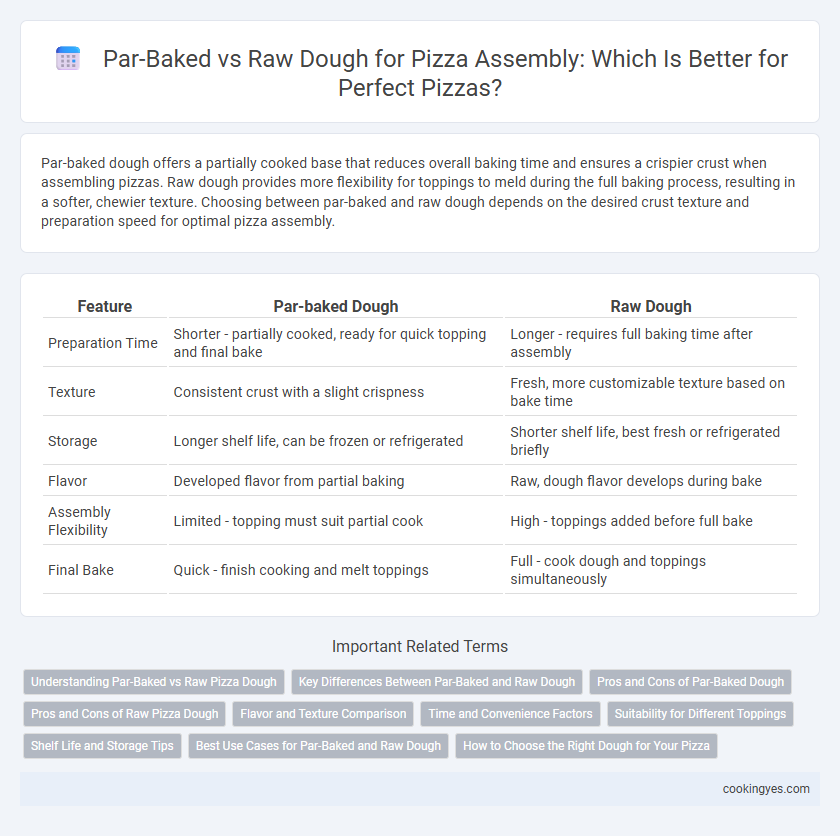Par-baked dough offers a partially cooked base that reduces overall baking time and ensures a crispier crust when assembling pizzas. Raw dough provides more flexibility for toppings to meld during the full baking process, resulting in a softer, chewier texture. Choosing between par-baked and raw dough depends on the desired crust texture and preparation speed for optimal pizza assembly.
Table of Comparison
| Feature | Par-baked Dough | Raw Dough |
|---|---|---|
| Preparation Time | Shorter - partially cooked, ready for quick topping and final bake | Longer - requires full baking time after assembly |
| Texture | Consistent crust with a slight crispness | Fresh, more customizable texture based on bake time |
| Storage | Longer shelf life, can be frozen or refrigerated | Shorter shelf life, best fresh or refrigerated briefly |
| Flavor | Developed flavor from partial baking | Raw, dough flavor develops during bake |
| Assembly Flexibility | Limited - topping must suit partial cook | High - toppings added before full bake |
| Final Bake | Quick - finish cooking and melt toppings | Full - cook dough and toppings simultaneously |
Understanding Par-Baked vs Raw Pizza Dough
Par-baked pizza dough is partially cooked, offering a firm crust that reduces assembly time and prevents sogginess during topping application. Raw pizza dough requires longer baking and offers greater flexibility for customization but demands careful handling to avoid undercooking or uneven texture. Choosing between par-baked and raw dough depends on the desired balance of convenience, texture, and flavor precision in pizza preparation.
Key Differences Between Par-Baked and Raw Dough
Par-baked dough is partially baked before assembly, offering a firmer texture and reduced baking time, which helps prevent sogginess when added toppings are applied. Raw dough requires a full baking process after assembly, allowing for a fresher crust but increasing the risk of uneven cooking and longer preparation. Choosing between par-baked and raw dough impacts pizza assembly efficiency, crust texture, and final product consistency.
Pros and Cons of Par-Baked Dough
Par-baked dough offers the advantage of a crispier crust and faster final assembly time since it is partially cooked, reducing the risk of undercooked centers. It allows for better control over texture and shelf life, yet can result in a slightly drier or less fresh taste compared to raw dough. Using par-baked dough streamlines high-volume production but may limit customization and the signature chewiness found in freshly baked pizzas.
Pros and Cons of Raw Pizza Dough
Raw pizza dough offers superior flexibility for customization during assembly, allowing precise shaping and topping distribution without pre-baking constraints. It requires longer preparation time and skill to avoid undercooking or dough sogginess, posing challenges in consistent texture and flavor development. Storage and handling demand careful temperature control to prevent premature fermentation or drying, impacting overall pizza quality.
Flavor and Texture Comparison
Par-baked pizza dough offers a slightly crispy crust with a consistent texture that helps preserve toppings during final baking, enhancing overall flavor through gentle caramelization. Raw dough, by contrast, allows for a chewier, more bread-like crust with a fresher yeast flavor and greater customization in baking time and temperature. Flavor intensity and texture depend heavily on the dough's fermentation time and hydration level, impacting moisture retention and crust density in both methods.
Time and Convenience Factors
Par-baked dough significantly reduces overall pizza assembly time by offering a pre-cooked base that requires minimal baking for finishing, enhancing convenience for quick service environments. Raw dough demands longer preparation and proofing times, making it less suitable for fast-paced operations where time efficiency is critical. Choosing par-baked dough optimizes workflow by streamlining baking processes and ensuring consistent quality with reduced handling.
Suitability for Different Toppings
Par-baked pizza dough offers a sturdier base ideal for heavy or moisture-rich toppings like vegetables, meats, and cheeses, preventing sogginess during final baking. Raw dough allows for greater absorption of sauce and toppings' flavors, resulting in a softer, chewier crust suited to lighter or thinner toppings such as herbs and delicate vegetables. Choosing between par-baked and raw dough depends on the desired texture and topping moisture content to achieve optimal pizza assembly and bake quality.
Shelf Life and Storage Tips
Par-baked pizza dough offers a longer shelf life compared to raw dough, typically lasting up to 7-10 days refrigerated due to partial cooking that slows microbial growth. Raw dough requires refrigeration and should be used within 3-5 days to maintain optimal freshness and prevent over-fermentation. For best results, store par-baked dough tightly wrapped or in airtight containers to avoid moisture loss, while raw dough benefits from being kept in plastic wrap or sealed bags to retain hydration and elasticity.
Best Use Cases for Par-Baked and Raw Dough
Par-baked dough offers a crisp, stable crust perfect for quick assembly in commercial kitchens and fast-paced environments where speed is essential. Raw dough provides maximum flexibility for customization, allowing pizzerias to shape, proof, and bake fresh pizzas with a tender, chewy texture desired by artisanal shops. Best use cases for par-baked dough include frozen pizza manufacturing and fast food chains, while raw dough suits gourmet restaurants and local pizzerias emphasizing freshness.
How to Choose the Right Dough for Your Pizza
Choosing between par-baked and raw dough depends on your desired cooking time and final texture; par-baked dough offers a quicker assembly with a crispier crust, while raw dough allows for more control over thickness and chewiness. Consider the oven type and temperature, as par-baked dough suits high-heat commercial ovens, whereas raw dough is ideal for home ovens with longer baking times. Packaging and storage preferences also impact the choice, with par-baked dough providing convenience and longer shelf life compared to raw dough's freshness and flexibility.
Par-baked vs Raw dough for assembly Infographic

 cookingyes.com
cookingyes.com